牛津上海版八年级英语上册教学课件:Unit 4 Numbers Reading (共34张PPT)
文档属性
| 名称 | 牛津上海版八年级英语上册教学课件:Unit 4 Numbers Reading (共34张PPT) | 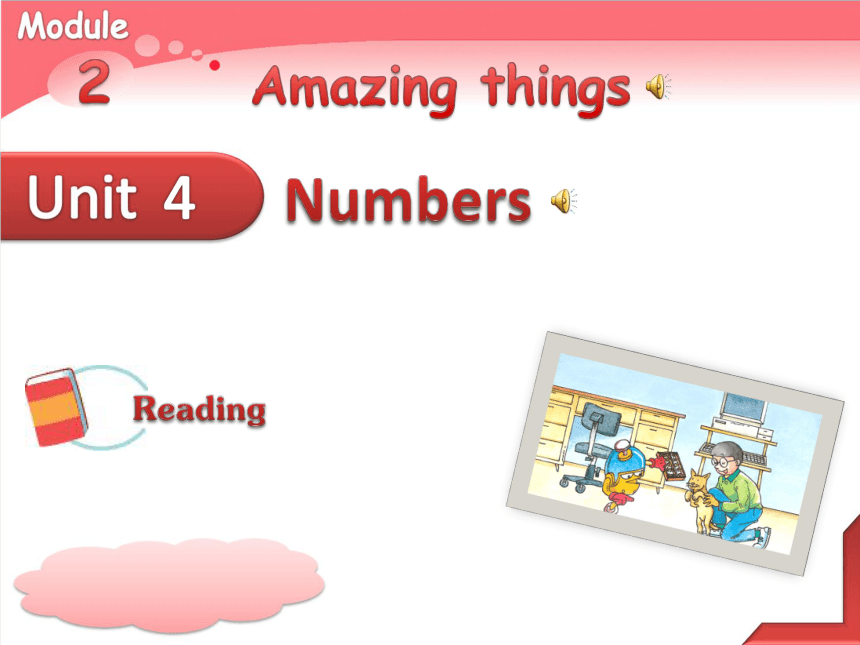 | |
| 格式 | zip | ||
| 文件大小 | 27.6MB | ||
| 资源类型 | 教案 | ||
| 版本资源 | 牛津上海版(试用本) | ||
| 科目 | 英语 | ||
| 更新时间 | 2016-08-24 15:07:01 | ||
图片预览

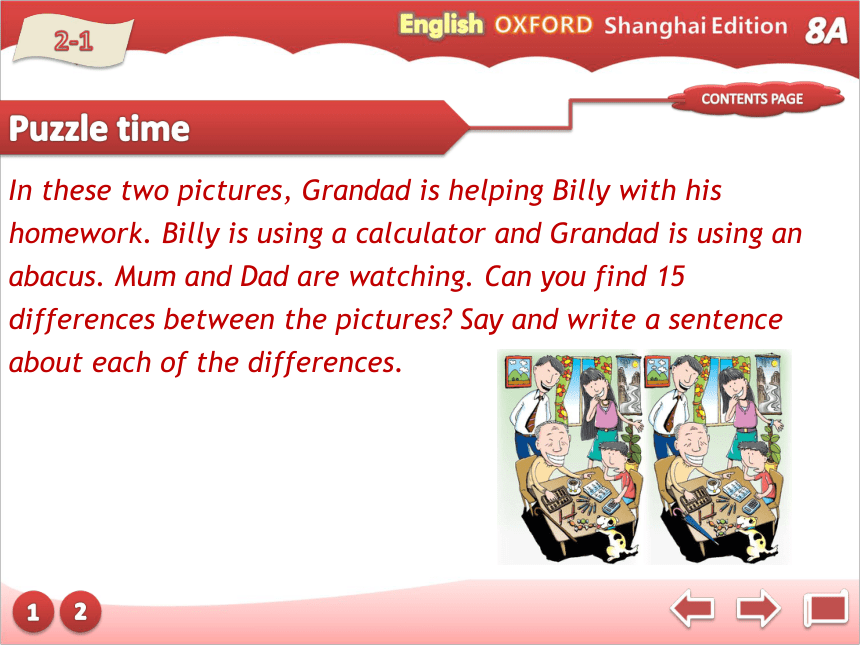


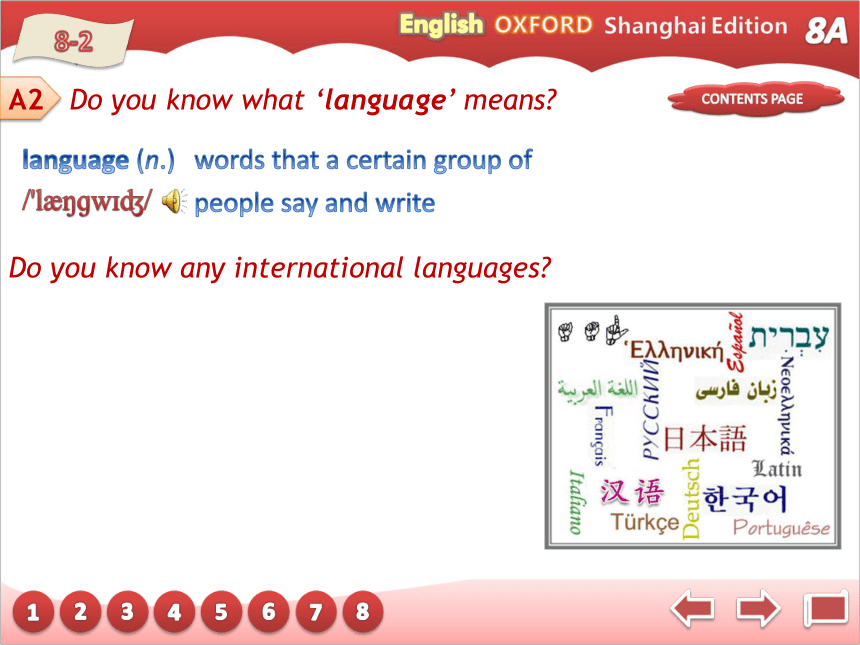

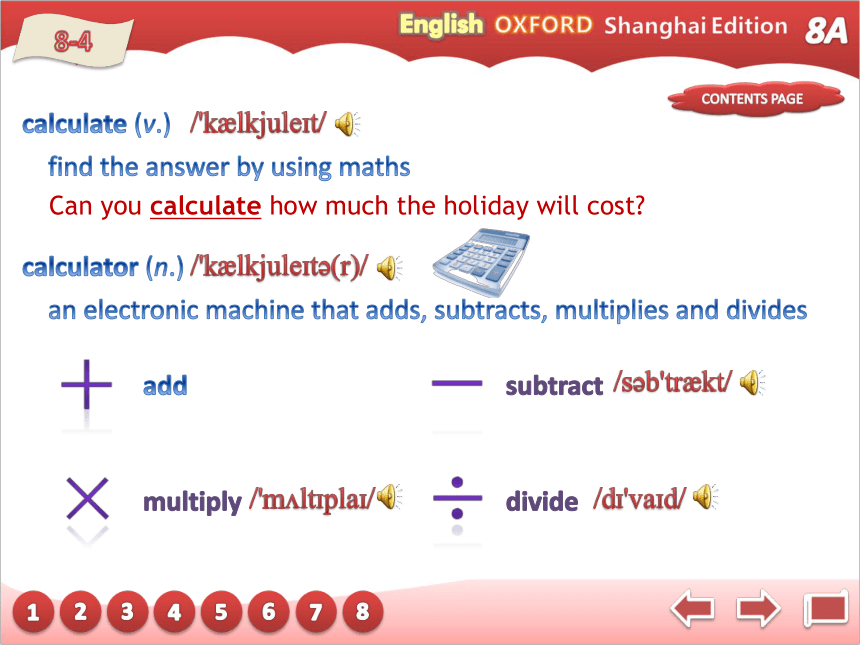
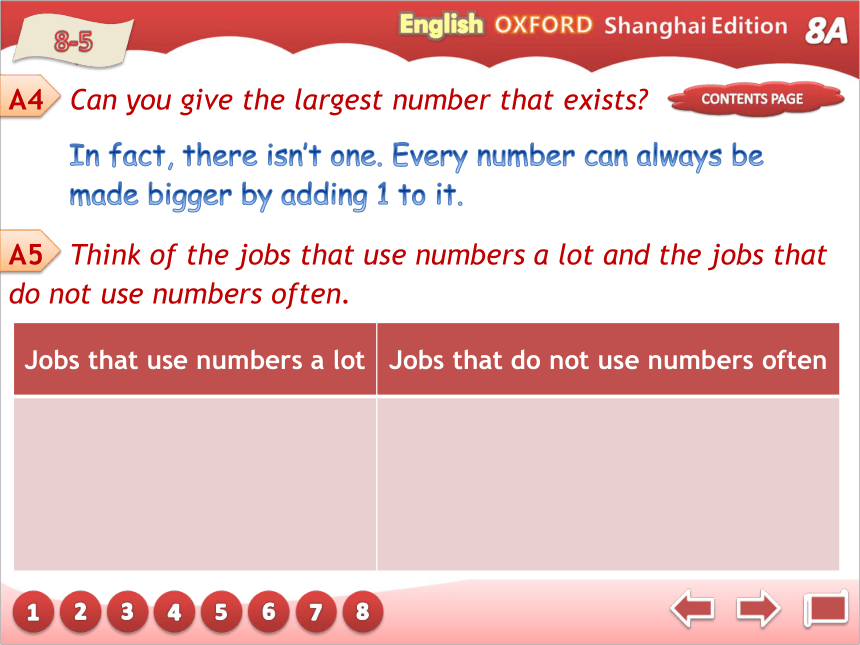
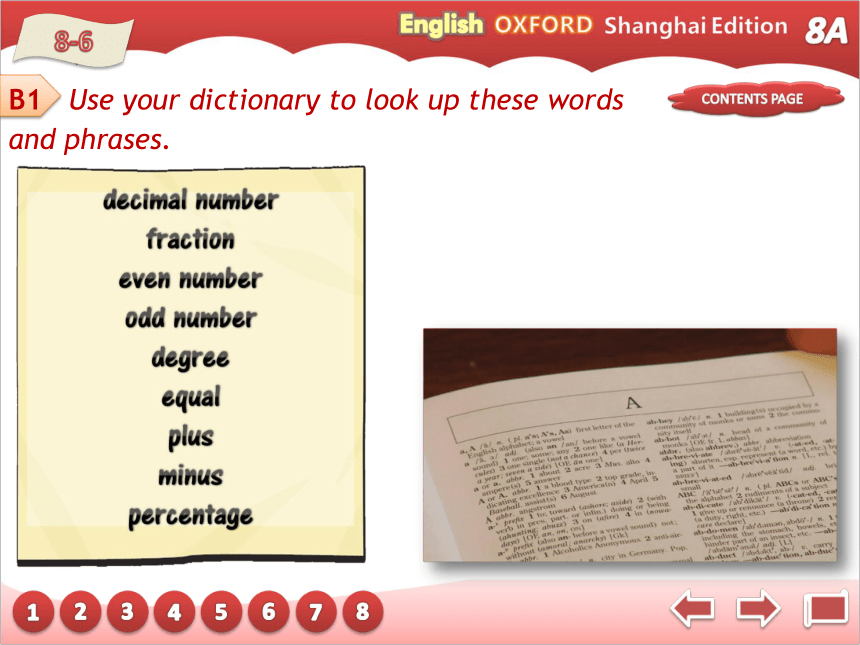


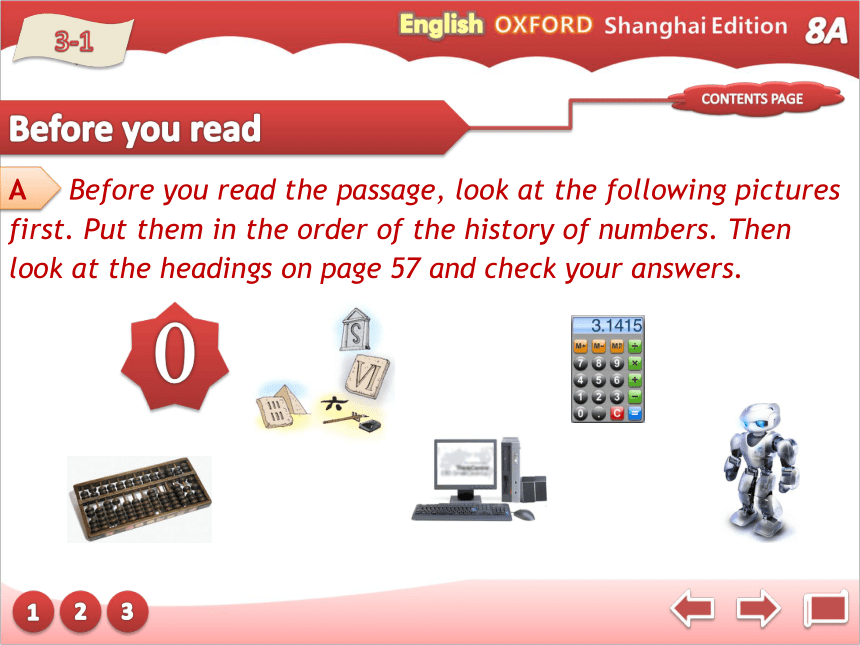
文档简介
课件34张PPT。24Amazing thingsNumbersReading122-1Puzzle timeIn these two pictures, Grandad is helping Billy with his homework. Billy is using a calculator and Grandad is using an abacus. Mum and Dad are watching. Can you find 15 differences between the pictures? Say and write a sentence about each of the differences.2-212ABExample:
In Picture A there are four sweets, but in Picture B there are five sweets.128-1What do you know about …?A1 We are going to read about an international language – numbers. Do you remember what ‘international’ means? 345international between different nations or countries678A2 Do you know what ‘language’ means?8-212345language (n.) words that a certain group of people say and write/'l??ɡw??/Do you know any international languages?678A3 The word digit has two meanings, a number (1, 2, 3, etc.) and a finger. The words calculator and calculate came from a word that meant a stone. Guess the connections between number and finger and between stone and calculator.8-312345Before numbers were invented, people counted with their fingers or with stones.digit10+10=?6788-412345calculate (v.)
find the answer by using maths/'k?lkjule?t/Can you calculate how much the holiday will cost?calculator (n.)
an electronic machine that adds, subtracts, multiplies and divides/'k?lkjule?t?(r)/+-×÷addsubtractmultiplydivide/s?b'tr?kt//'m?lt?pla?//d?'va?d/6788-512345A4 Can you give the largest number that exists?In fact, there isn’t one. Every number can always be made bigger by adding 1 to it.A5 Think of the jobs that use numbers a lot and the jobs that do not use numbers often.6788-612345B1 Use your dictionary to look up these words and phrases.6788-712345B2 We all use numbers in our daily life. Numbers are an international language. What do you know about the language of numbers? Try this quiz. Match the words with the signs and numbers.6781 a decimal number 7 add; plus
2 equals 8 subtract; minus
3 a pair of odd numbers 9 multiply
4 a pair of even numbers 10 divide
5 a fraction 11 a number showing degrees
6 zero 12 a percentage8-812345123456789101112/d?'ɡri://p?'sent??/678123-1Before you readA Before you read the passage, look at the following pictures first. Put them in the order of the history of numbers. Then look at the headings on page 57 and check your answers. 303-2123This history of numbers0Ancient numbersZeroCalculating machinesBrain against computerB Now, look at the title, the introduction, the headings and the pictures. Then on the list below, tick (?) the things you think the article may tell you. 3-3123Long ago, there were different ways of writing numbers.
Zero is not a number.
Zero is an especially important number.
Machines make it easier for us to calculate.
Your brain may calculate better than a computer.
Your brain is an important part of your body.?
?
?
?
?
?????While you read16-112345A1 Read the whole passage on page 57 for the first time. Find the following words or phrases in the passage. Work out their meanings by yourself.67891011121314151616-2A2 Choose the right meanings for these words.nearly a most b almost
invented a did not like b made for the first time
accurate
a correct b easy1234567891011121314151616-312345678910111213141516in a flash a in a long time b in a short time
lifetime a time that somebody works b time that somebody lives
like lightning a very quickly b very slowly18-412345678910111213141516A3 Match the words in Column A with the meanings in Column B.16-512345678910111213141516A4 Write the words that go with the descriptions.1An ancient calculating machine that is still use today.2A living computer.3A small machine that uses electronic power to do calculations.4A very powerful machine for doing calculations.An ____________.The ____________.A ____________.A ____________.abacusbraincalculatorcomputer16-612345678910111213141516B Read the passage.How many languages do you know? Everyone knows at least two—his or her own language and the international language of numbers.16-712345678910111213141516In ancient times, people wrote numbers in many different ways, as these pictures of the number 6 show. However, they nearly all counted in the same way—in tens.Ancient numbers16-812345678910111213141516ZeroMost of us use the system of numbers with numbers from 1 to 9 and 0 (zero). With these ten numbers, we can write any number from the biggest to the smallest. The Indians first invented and developed the 1 to 9 system of numbers. They then invented the zero. This was a very important invention because it made it easier to write big numbers and to calculate.16-912345678910111213141516Calculating machinesOne of the first calculating machines was an abacus. Abacuses are so fast and accurate that people still use them today.
A modern electronic calculator can add, subtract, multiply and divide. It can also calculate percentages and square roots.
Computers are very powerful calculating machines. In a flash, a computer can do a calculation that you could not do in your whole lifetime.Find the number that, when it is multiplied 23 times by itself, gives this answer:
91674867692003915809866092758538016248310668014430862240712651642793465704086709659327920576748080679002278301635492485238033574531693511190359657754734007568168830562082101612913284554680578015880677116-1012345678910111213141516Brain against computerSome people call the brain a living computer. Is a human brain a more powerful calculator than a computer? The following story may give an answer.
Shakuntala Devi is a lady from India with an amazing brain. Shakuntala and a very powerful computer were given this problem to solve.16-1112345678910111213141516Shakuntala’s brain took fifty seconds to find the answer, like lightning. The computer took a minute. However, someone had to first program the computer with instructions, and that took many hours. No one had to program Shakuntala!
Use your own living computer to solve the problem above. If it is not powerful enough, you will find the answer on page 67.Answer: 546, 372, 891.Passage16-1212345678910111213141516C May is asking Mr Li, the writer, some questions about his article on numbers. His answers are not quite clear. Read the article again and make his answers clearer. The first one has been done for you.18-1312345678910111213141516languagenumbersNumbersIn tensZeroAbacusesCalculating machineshuman braincomputer16-1412345678910111213141516D Complete answers to these questions about Mr Li’s article. Work alone or in pairs.16-1512345678910111213141516Can you explain why we count in tens? We count in tens because we have __________ fingers.
Which did the Indians invent first, the 1 to 9 number system or the zero? They invented the ____________________________ first.ten1 to 9 number system16-1612345678910111213141516Can you complete this sentence with three words to tell us that a computer works very fast? A computer can do a calculation _____________.
Can you use two words to tell us that Shakuntala’s brain works very fast? It can do a calculation _____________.
Is a human brain a more powerful calculator than a computer? Why? __________________________________________________________________________________________in a flashlike lightning(You can write your own answer here.)After you read3-1A Work in pairs. Ask and answer question about Mr Li’s article on numbers. S1 asks the questions and S2 tries to answer his or her questions.123B Complete the summary.3-2123Ancient numbers — In ancient times, people wrote numbers _______ ____________, but they are nearly counted _____________________.
Zero — Everyone uses the __________________ 1 to 9 plus 0 (zero). The __________ invented them. _________ makes it _________ to write big numbers and to calculate.
Calculating machines — The three calculating machines: the ____________, the ____________ and the ____________ make our life easier.
Brain against computer — There was once a competition between an Indian __________ and a __________ in which the __________ won. Computers cannot do anything by themselves. ___________________ must program them first.indifferent waysin tensnumber systemIndiansZeroeasierabacusescalculatorscomputersladycomputerladyHuman beingsC Say something about the history of numbers according to the pictures below.3-3123ConsolidationWorkbook 8A, pages 31, 37 and 38.
In Picture A there are four sweets, but in Picture B there are five sweets.128-1What do you know about …?A1 We are going to read about an international language – numbers. Do you remember what ‘international’ means? 345international between different nations or countries678A2 Do you know what ‘language’ means?8-212345language (n.) words that a certain group of people say and write/'l??ɡw??/Do you know any international languages?678A3 The word digit has two meanings, a number (1, 2, 3, etc.) and a finger. The words calculator and calculate came from a word that meant a stone. Guess the connections between number and finger and between stone and calculator.8-312345Before numbers were invented, people counted with their fingers or with stones.digit10+10=?6788-412345calculate (v.)
find the answer by using maths/'k?lkjule?t/Can you calculate how much the holiday will cost?calculator (n.)
an electronic machine that adds, subtracts, multiplies and divides/'k?lkjule?t?(r)/+-×÷addsubtractmultiplydivide/s?b'tr?kt//'m?lt?pla?//d?'va?d/6788-512345A4 Can you give the largest number that exists?In fact, there isn’t one. Every number can always be made bigger by adding 1 to it.A5 Think of the jobs that use numbers a lot and the jobs that do not use numbers often.6788-612345B1 Use your dictionary to look up these words and phrases.6788-712345B2 We all use numbers in our daily life. Numbers are an international language. What do you know about the language of numbers? Try this quiz. Match the words with the signs and numbers.6781 a decimal number 7 add; plus
2 equals 8 subtract; minus
3 a pair of odd numbers 9 multiply
4 a pair of even numbers 10 divide
5 a fraction 11 a number showing degrees
6 zero 12 a percentage8-812345123456789101112/d?'ɡri://p?'sent??/678123-1Before you readA Before you read the passage, look at the following pictures first. Put them in the order of the history of numbers. Then look at the headings on page 57 and check your answers. 303-2123This history of numbers0Ancient numbersZeroCalculating machinesBrain against computerB Now, look at the title, the introduction, the headings and the pictures. Then on the list below, tick (?) the things you think the article may tell you. 3-3123Long ago, there were different ways of writing numbers.
Zero is not a number.
Zero is an especially important number.
Machines make it easier for us to calculate.
Your brain may calculate better than a computer.
Your brain is an important part of your body.?
?
?
?
?
?????While you read16-112345A1 Read the whole passage on page 57 for the first time. Find the following words or phrases in the passage. Work out their meanings by yourself.67891011121314151616-2A2 Choose the right meanings for these words.nearly a most b almost
invented a did not like b made for the first time
accurate
a correct b easy1234567891011121314151616-312345678910111213141516in a flash a in a long time b in a short time
lifetime a time that somebody works b time that somebody lives
like lightning a very quickly b very slowly18-412345678910111213141516A3 Match the words in Column A with the meanings in Column B.16-512345678910111213141516A4 Write the words that go with the descriptions.1An ancient calculating machine that is still use today.2A living computer.3A small machine that uses electronic power to do calculations.4A very powerful machine for doing calculations.An ____________.The ____________.A ____________.A ____________.abacusbraincalculatorcomputer16-612345678910111213141516B Read the passage.How many languages do you know? Everyone knows at least two—his or her own language and the international language of numbers.16-712345678910111213141516In ancient times, people wrote numbers in many different ways, as these pictures of the number 6 show. However, they nearly all counted in the same way—in tens.Ancient numbers16-812345678910111213141516ZeroMost of us use the system of numbers with numbers from 1 to 9 and 0 (zero). With these ten numbers, we can write any number from the biggest to the smallest. The Indians first invented and developed the 1 to 9 system of numbers. They then invented the zero. This was a very important invention because it made it easier to write big numbers and to calculate.16-912345678910111213141516Calculating machinesOne of the first calculating machines was an abacus. Abacuses are so fast and accurate that people still use them today.
A modern electronic calculator can add, subtract, multiply and divide. It can also calculate percentages and square roots.
Computers are very powerful calculating machines. In a flash, a computer can do a calculation that you could not do in your whole lifetime.Find the number that, when it is multiplied 23 times by itself, gives this answer:
91674867692003915809866092758538016248310668014430862240712651642793465704086709659327920576748080679002278301635492485238033574531693511190359657754734007568168830562082101612913284554680578015880677116-1012345678910111213141516Brain against computerSome people call the brain a living computer. Is a human brain a more powerful calculator than a computer? The following story may give an answer.
Shakuntala Devi is a lady from India with an amazing brain. Shakuntala and a very powerful computer were given this problem to solve.16-1112345678910111213141516Shakuntala’s brain took fifty seconds to find the answer, like lightning. The computer took a minute. However, someone had to first program the computer with instructions, and that took many hours. No one had to program Shakuntala!
Use your own living computer to solve the problem above. If it is not powerful enough, you will find the answer on page 67.Answer: 546, 372, 891.Passage16-1212345678910111213141516C May is asking Mr Li, the writer, some questions about his article on numbers. His answers are not quite clear. Read the article again and make his answers clearer. The first one has been done for you.18-1312345678910111213141516languagenumbersNumbersIn tensZeroAbacusesCalculating machineshuman braincomputer16-1412345678910111213141516D Complete answers to these questions about Mr Li’s article. Work alone or in pairs.16-1512345678910111213141516Can you explain why we count in tens? We count in tens because we have __________ fingers.
Which did the Indians invent first, the 1 to 9 number system or the zero? They invented the ____________________________ first.ten1 to 9 number system16-1612345678910111213141516Can you complete this sentence with three words to tell us that a computer works very fast? A computer can do a calculation _____________.
Can you use two words to tell us that Shakuntala’s brain works very fast? It can do a calculation _____________.
Is a human brain a more powerful calculator than a computer? Why? __________________________________________________________________________________________in a flashlike lightning(You can write your own answer here.)After you read3-1A Work in pairs. Ask and answer question about Mr Li’s article on numbers. S1 asks the questions and S2 tries to answer his or her questions.123B Complete the summary.3-2123Ancient numbers — In ancient times, people wrote numbers _______ ____________, but they are nearly counted _____________________.
Zero — Everyone uses the __________________ 1 to 9 plus 0 (zero). The __________ invented them. _________ makes it _________ to write big numbers and to calculate.
Calculating machines — The three calculating machines: the ____________, the ____________ and the ____________ make our life easier.
Brain against computer — There was once a competition between an Indian __________ and a __________ in which the __________ won. Computers cannot do anything by themselves. ___________________ must program them first.indifferent waysin tensnumber systemIndiansZeroeasierabacusescalculatorscomputersladycomputerladyHuman beingsC Say something about the history of numbers according to the pictures below.3-3123ConsolidationWorkbook 8A, pages 31, 37 and 38.
